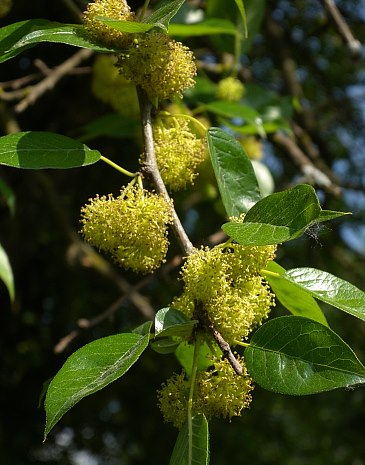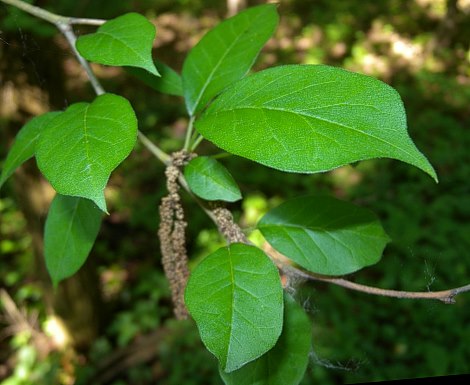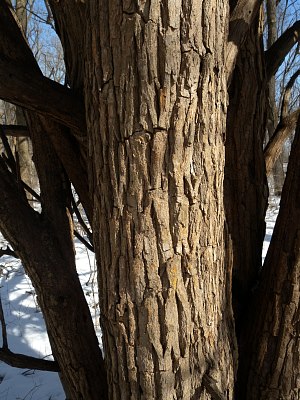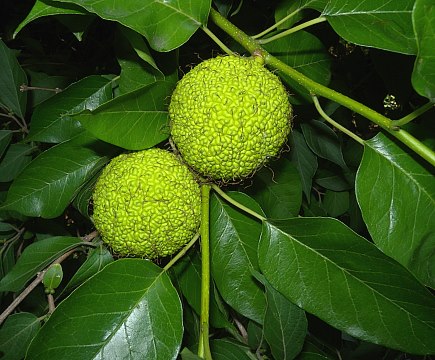Osage
Orange
Maclura pomifera
Mulberry family (Moraceae)
Description:
This small tree is 25-50' tall at maturity, forming a short stout trunk
(1-3' across) and a globoid crown with ascending to widely spreading
branches. Outer branches have a tendency to droop at the bottom of the
crown. The trunk bark is brown to orange-brown and deeply
furrowed with
prominent ridges that are straight, slightly curved, or forked. The
bark of branches and twigs is orange-brown to gray-brown and more
smooth; twigs have a slight tendency to zigzag and they are often
thorny. The thorns are ¼-1" long, straight, and stout.
Young shoots are green, glabrous, and terete with alternate
deciduous leaves. Individual leaves are 2½-5" long and 1½-2½" across;
they are lanceolate-ovate with long tapering tips and smooth to
slightly undulate along their margins. The upper leaf surface is medium
to dark green and glabrous, while the lower surface is pale green and
pubescent. The slender petioles are 1-2¼" long and either glabrous or
short-pubescent.
Osage Orange is dioecious, forming male and female
flowers on separate trees. Male flowers develop in 1-3 racemes from
the axils of the leaves; individual racemes are about 1-2" long and
about ¾-1½" across, drooping downward from peduncles about ¾-2"
long. Individual male flowers are up to 1/8" (3 mm.) across, consisting
of a
pubescent green calyx with 4 lobes and 4 stamens with yellow anthers;
the male flowers are greenish yellow overall. Female flowers are
arranged in green globoid heads about ¾-1" across; these flowerheads
are produced individually or in clusters of 2-3 from the axils of the
leaves on short pedicels up to ¼" long. Each flowerhead has up to 200
female flowers that are compressed tightly together. Each female flower
consists of a thick green calyx with 4 lobes, a sessile ovary, and
a single style with 2 long filiform divisions; the calyx and ovary are
largely hidden from
view. Because of the slender divisions of the styles, the flowerhead
has a hairy
appearance. The flowers are cross-pollinated by the wind during the
late spring or early summer for about 1-2 weeks; this occurs after the
leaves have developed. The male flowers soon wither away, while the
female flowerheads are transformed into globoid fruits (compound
drupes) that become steadily larger in size during the summer. These
hard fleshy fruits become 4-6" across during the fall and turn greenish
yellow at maturity; they have an aroma that is similar to the fruits of
citrus trees. The surface of each fruit is intricately wrinkled and
tuberculate. Each fertile fruit contains up to 200 seeds; when
cross-pollination doesn't occur, the fruits are seedless. The root
system is widely spreading and deep.
Cultivation:
The preference is full
or partial sun and moist to dry-mesic conditions. Practically any kind
of soil is tolerated as long as it is not highly acidic. Because of its
strong and flexible wood, this tree has high resistance to damage from
wind, hail, and ice. It is less tolerant of shade than most trees and
there are few problems with insects and disease. Because of
the large heavy fruits, female trees should not be located near
sidewalks, driveways, or rooftops.
Range
& Habitat: Osage Orange is relatively common
throughout Illinois,
except in some NW areas of the state, where it is less common or absent
(see Distribution
Map). Overall, the abundance of this tree has
declined somewhat because of the destruction of fence rows and hedges
by farmers in agricultural areas. Osage Orange was introduced into
Illinois to create windbreaks and to establish thorny hedges that could
control the movement of farm animals. It is native to Texas,
Oklahoma, and adjacent areas of the southern plains. Habitats include
floodplain woodlands, thickets, savannas, fence rows, and
overgrazed pastures. This tree is usually found in
disturbed areas, and it is occasionally cultivated as a
landscape tree.



